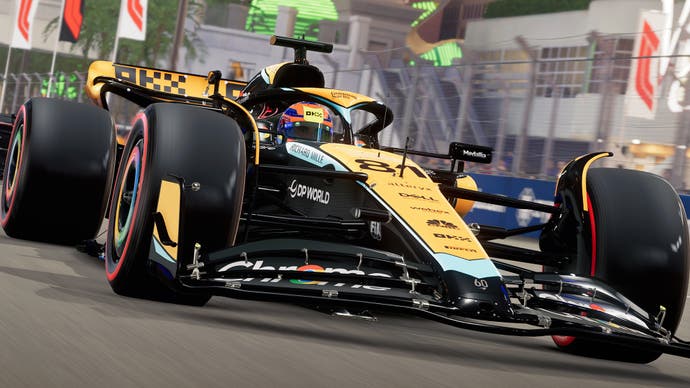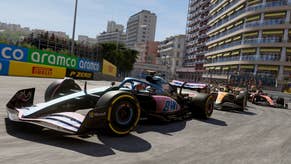F1 23: a huge technical upgrade - but do the new RT features make a difference?
Xbox Series X/S, PS5 and PC tested.
The release of Codemaster's F1 23 gives us the most complete version of the series to date, with an upgraded version of its in-house EGO Engine and the return of the fan-favourite Braking Point story mode. The game also includes more ray tracing features, as this year dynamic diffuse global illumination (DDGI) is added on PlayStation 5, Xbox Series X, Series S and PC. DDGI extends an already deep list of RT technologies from last year's game, which included reflections, ambient occlusion and shadows. Going into the game, I was curious to see how much of an upgrade DDGI enables, how close PS5 and Series X can come to the maxed-out PC version, and what settings make sense for PC players.
Let's get to the basics first. Both PS5 and Xbox Series X target a full 3840x2160 during gameplay, with matching shadows, textures and draw distances. Interestingly, the game's many RT features are only active during menu sequences, pre-race buildup and replays. Once the race begins, traditional rasterised techniques like screen space reflections (SSR) and ambient occlusion (SSAO) replace the RT reflections, RT shadows, RTAO, and DDGI. These less demanding techniques allow these consoles to hit the full 4K, while with RT enabled you'll see scaling from lower resolutions - the lowest I spotted was 3072x1728 during replays (80 percent of 4K). Alongside the resolution drop, these RT-enabled areas also tend to run at an obviously sub-60fps frame-rate, including a 30fps cap in the menus.
Series S is an interesting one, as it has all of the same quality settings and RT features as on PS5 and Series X, and all of the same compromises too. However, the game does run at a lower resolution, with a 1080p target that holds up reasonably well with the game's temporal anti-aliasing (TAA). In RT areas, dynamic resolution scaling is again used, but the game remains close to 1080p even in the most challenging menu sequences.
Performance in F1 23 is a curious point. Whether it's PS5, Series X or Series S, Codemasters has put in the legwork to make sure the default quality mode offers a rock solid 60fps on each console during the race, including in compact, rain-slick circuits like Monaco with all cars in view at the start. On the grid before the race and as the AI controls the car after the chequered flag though, RT is enabled and the frame-rate is unlocked, giving us a glimpse at the actual cost of these visual niceties. Here, we spotted frame-rates around 30-40fps on all consoles, with screen tearing evident all across the frame. The frame-rate even drops below 30fps as the drivers are shown in the podium ceremony. None of this harms gameplay of course, but it's an interesting insight none the less.
There's also a 120Hz performance mode, which appears only on PS5 and Series X. This drops the target resolution to 1440p, with the internal resolution dropping down to 720p at worst. In exchange though, you get a locked 120fps experience during the race itself which is great for competitive play if you can abide the lack of visual clarity.
The pre- and post-race sequences still engage RT in this mode, with performance dropping to the 40-50fps range. That suggests that an alternate 60fps RT mode might be possible, but it would likely need to run at an even lower resolution than 1440p - or be reserved for players with VRR displays.



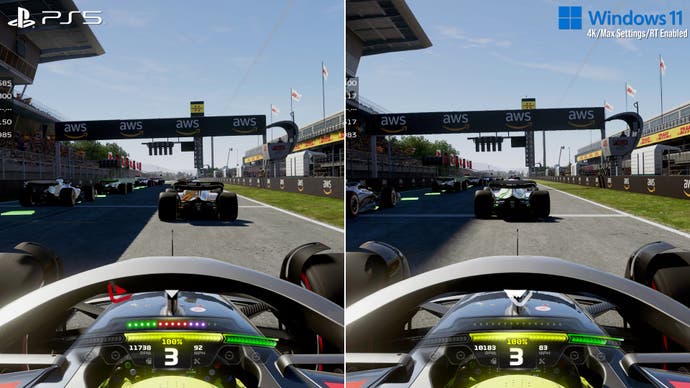
In the here and now, the only route to RT during gameplay is on PC. I tested the PC edition with a high-end system, powered by an AMD Ryzen 7 5700X CPU and an Nvidia RTX 4080 graphics card. Despite this surfeit of power, this configuration isn't quite capable of delivering a locked 60fps with all RT features engaged at native 4K, instead ending up around the 50fps mark during the run of play at a rainy Monaco. Thankfully, enabling DLSS quality mode, which upscales from 1440p, delivers around an 80fps average frame-rate without a noticeable impact to fidelity. XeSS and FSR 2 are also available, so users of Intel, AMD and Nvidia cards all have a range of upscaling options to choose from which we love to see.
Enabling all of the RT features together has a transformative effect on gameplay, with ray-traced reflections, shadows, AO, transparencies and the new DDGI all contributing. Of these, ray-traced reflections are easily the most clear-cut upgrade, although this can range from huge to subtle depending on the circuit and weather conditions. The walls of Monaco's famous tunnel are a highlight, with the glossy surface mirroring the streetlights, the road signs and the detailing of the tunnel. It's all factored in, and even distorts based on the pattern of the tiling. Regular SSR still does a respectable job, but the coverage isn't complete. Car bodies also benefit from RT reflections, especially in cockpit view, with the fins at either side of the car reflecting back on its glossy finish and the steering wheel and hands reflecting around the interior of the cockpit.
The impact of ray traced reflections isn't always obvious. In fact, the benefit of the ray traced approach is often in its subtlety, in pushing for a truer-to-life result. Case in point is a night-time race with weather set to heavy rainfall. You'd expect this to be a perfect showcase for reflections, but this depends on the technique used. The non-RT SSR approach used by PS5 and Series X during gameplay produces a clear, if often exaggerated mirror image, while the RT version factors in the way the light hits the coarse road surface, the way it refracts and diffuses the detail for a more realistic but perhaps less exciting result.
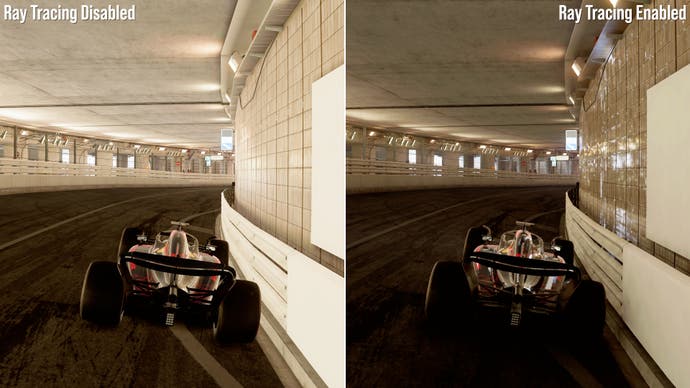


The SSR used on PC, PS5 and Series X seems to exhibit a bug too, in that the brightness level of the reflection doesn't match the brightness of the object. It appears that the screen-space image is taken before shadows are factored in, creating an oddly vivid reflection that's a mismatch for the object itself. RT solves this, with colour and brightness perfectly in line.
Next in terms of visual impact are RT shadows, which show contact hardening - how shadows get more diffuse the further from their casting object they become. This isn't an essential detail, or as obvious as reflections, but it's a nice extra. RTAO operates to a similar degree, providing thicker and more detailed shading across the track and adding much-needed depth to the scene.
Finally, DDGI gives us ray-traced light bounce between surfaces, helping to light the corners of rooms and reflect points of colour between two nearby surfaces. Again, like the other RT techniques this appears only outside of gameplay for the console editions, while on PC it can be enabled throughout. The impact is quite subtle in my experience, perhaps being most obvious in menus and vehicle showrooms. By toggling the setting on and off in isolation, we can see how it adds extra light bounces from open windows and overhead lamps which brighten a room's corners, while dark wood and red carpets colour nearby sofas. Likewise, the underside of a Ferrari in a showroom is brightened, while the chassis and tyres pick up the green glow of the walls. It works, but in gameplay it doesn't provide a huge impact.

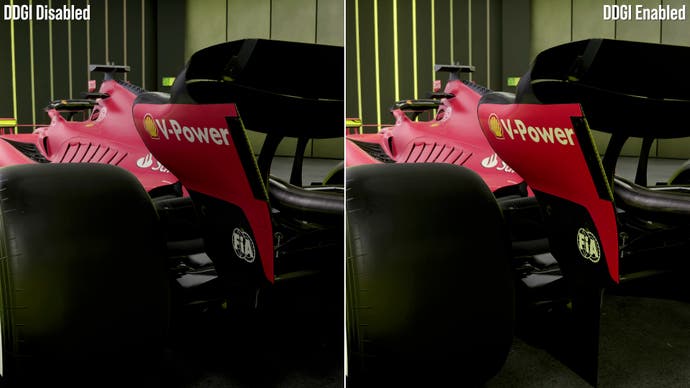
All things considered then, F1 23's ray tracing loadout on consoles and PC makes a lot of sense given its obvious cost. It is a shame to lose these RT features during a race, especially in dark and wet environments, given the vast improvements to reflections and ambient occlusion on PC with RT enabled. However, disabling these features to hit a locked 60 or 120fps on console while still maintaining a high resolution presentation is clearly the right choice. The only real snag is the lack of a 120Hz mode on Series S, but given the reduced resolution it's understandable.
On the plus side, Codemasters still shows off its RT flourishes on console, at slower points where they're perhaps better appreciated like replays or menus. I'd still be fascinated to see if ray tracing in gameplay is at all possible on console, even as an experimental extra mode. The 120Hz mode already drops resolution to achieve a better frame-rate (if still shy of 60fps), so it seems like a technical possibility - even if it might not be the mode we'd recommend by default.
As it stands though, F1 23 is in fine shape, and it'll be interesting to see how the next game pushes its EGO Engine tech.
